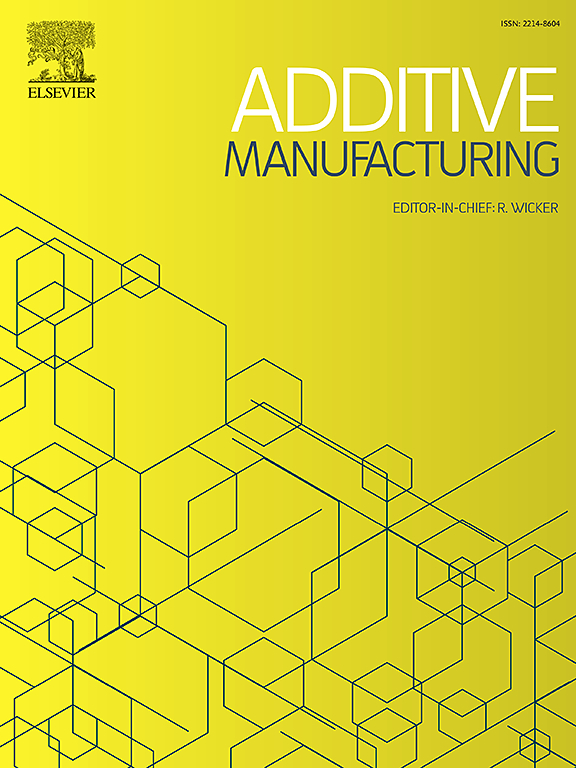Effect of Zr and Sc additions on coarsening- and creep resistance of AlSi10Mg fabricated by laser powder bed fusion
IF 10.3
1区 工程技术
Q1 ENGINEERING, MANUFACTURING
引用次数: 0
Abstract
Microstructure and creep properties are studied in a eutectic AlSi10Mg alloy modified with Zr and Sc additions (Al-9.8Si-0.32Mg-0.70Zr-0.23Sc, wt%) manufactured through laser powder-bed fusion (L-PBF). Three types of Zr/Sc-bearing powders - elemental, master-alloy, and pre-alloyed - are employed in the fabrication process, with the pre-alloyed powders providing the highest incorporation of Zr and Sc in the Al matrix. The as-printed alloy exhibits a fine cellular Al-Si eutectic structure which fragments and coarsens into micron-sized Si particles during aging at 300 ºC, leading to a steady drop in alloy microhardness between 0.1 and 1000 h. Coarsening of the eutectic Si phase during aging is not measurably affected by Zr and Sc in solid solution, which precipitate during aging and increases strength, compensating weakening from Si coarsening between 1 and 200 h at 300 ºC. Atom-probe analysis in the peak-aged condition (96 h/300 °C) confirms the presence of Al3(Sc,Zr) secondary nano-precipitates with an average radius of 1.0 nm and some Si solubility. Micron-sized grains are present throughout the alloy, with ultra-fine-grained regions at the melt pool boundaries, neither of which coarsen during long-term aging at 300 ºC. Under creep conditions at 300 °C, the Zr/Sc-bearing alloy with Al3(Sc,Zr) nano-precipitates exhibits power-law behavior, with a high apparent stress exponent (na = 9) and a high threshold stress (σth = 43 MPa), exhibiting nearly double the strength of a Zr/Sc-free AlSi10Mg control alloy (σth = 22 MPa).
Zr和Sc添加量对激光粉末床熔敷AlSi10Mg合金抗粗化和抗蠕变性能的影响
研究了添加Zr和Sc改性的AlSi10Mg共晶合金(Al-9.8Si-0.32Mg-0.70Zr-0.23Sc, wt%)激光粉末床熔炼(L-PBF)的显微组织和蠕变性能。在制造过程中使用了三种类型的含Zr/Sc的粉末——元素、母合金和预合金,预合金粉末在Al基体中提供了最高的Zr和Sc掺入量。在300℃时效过程中,合金呈现出细小的胞状Al-Si共晶结构,晶粒破碎并粗化成微米级的Si颗粒,导致合金显微硬度在0.1 ~ 1000 h之间稳定下降。固溶体中的Zr和Sc对时效过程中共晶Si相的粗化没有明显的影响,它们在时效过程中析出并提高了强度,补偿了300℃下1 ~ 200 h之间Si粗化的减弱。峰时效条件下(96 h/300℃)原子探针分析证实了Al3(Sc,Zr)二次纳米沉淀的存在,平均半径为1.0 nm,并具有一定的Si溶解度。整个合金中存在微米级晶粒,在熔池边界处存在超细晶粒区域,在300℃的长期时效过程中两者均未变粗。在300℃蠕变条件下,含有Al3(Sc,Zr)纳米析出相的含Zr/Sc合金表现出幂律行为,具有较高的表观应力指数(na = 9)和较高的阈值应力(σth = 43 MPa),其强度几乎是不含Zr/Sc的AlSi10Mg对照合金(σth = 22 MPa)的两倍。
本文章由计算机程序翻译,如有差异,请以英文原文为准。
求助全文
约1分钟内获得全文
求助全文
来源期刊

Additive manufacturing
Materials Science-General Materials Science
CiteScore
19.80
自引率
12.70%
发文量
648
审稿时长
35 days
期刊介绍:
Additive Manufacturing stands as a peer-reviewed journal dedicated to delivering high-quality research papers and reviews in the field of additive manufacturing, serving both academia and industry leaders. The journal's objective is to recognize the innovative essence of additive manufacturing and its diverse applications, providing a comprehensive overview of current developments and future prospects.
The transformative potential of additive manufacturing technologies in product design and manufacturing is poised to disrupt traditional approaches. In response to this paradigm shift, a distinctive and comprehensive publication outlet was essential. Additive Manufacturing fulfills this need, offering a platform for engineers, materials scientists, and practitioners across academia and various industries to document and share innovations in these evolving technologies.
 求助内容:
求助内容: 应助结果提醒方式:
应助结果提醒方式:


